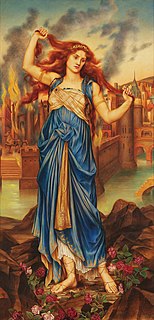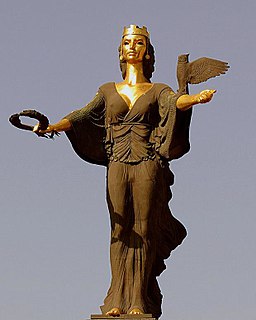Related Research Articles

Carl Gustav Jung ( YUUNG; German: [kaʁl ˈjʊŋ]; was a Swiss psychiatrist and psychoanalyst who founded analytical psychology. Jung's work has been influential in the fields of psychiatry, anthropology, archaeology, literature, philosophy, psychology, and religious studies. Jung worked as a research scientist at the famous Burghölzli hospital, under Eugen Bleuler. During this time, he came to the attention of Sigmund Freud, the founder of psychoanalysis. The two men conducted a lengthy correspondence and collaborated, for a while, on a joint vision of human psychology.
Collective unconscious refers to the unconscious mind and shared mental concepts. It is generally associated with idealism and was coined by Carl Jung. According to Jung, the human collective unconscious is populated by instincts, as well as by archetypes: ancient primal symbols such as The Great Mother, the Wise Old Man, the Shadow, the Tower, Water, and the Tree of Life. Jung considered the collective unconscious to underpin and surround the unconscious mind, distinguishing it from the personal unconscious of Freudian psychoanalysis. He believed that the concept of the collective unconscious helps to explain why similar themes occur in mythologies around the world. He argued that the collective unconscious had a profound influence on the lives of individuals, who lived out its symbols and clothed them in meaning through their experiences. The psychotherapeutic practice of analytical psychology revolves around examining the patient's relationship to the collective unconscious.

Analytical psychology is a term coined by Carl Jung, a Swiss psychiatrist, to describe research into his new "empirical science" of the psyche. It was designed to distinguish it from Freud's psychoanalytic theories as their seven-year collaboration on psychoanalysis was drawing to an end between 1912 and 1913. The evolution of his science is contained in his monumental opus, the Collected Works, written over sixty years of his lifetime.
James Hillman was an American psychologist. He studied at, and then guided studies for, the C.G. Jung Institute in Zurich. He founded a movement toward archetypal psychology and retired into private practice, writing and traveling to lecture, until his death at his home in Connecticut.
The anima and animus are described in Carl Jung's school of analytical psychology as part of his theory of the collective unconscious. Jung described the animus as the unconscious masculine side of a woman, and the anima as the unconscious feminine side of a man, each transcending the personal psyche. Jung's theory states that the anima and animus are the two primary anthropomorphic archetypes of the unconscious mind, as opposed to the theriomorphic and inferior function of the shadow archetypes. He believed they are the abstract symbol sets that formulate the archetype of the Self.
Depth psychology refers to the practice and research of the science of the unconscious, covering both psychoanalysis and psychology. It is also defined as the psychological theory that explores the relationship between the conscious and the unconscious, as well as the patterns and dynamics of motivation and the mind. The theories of Sigmund Freud, Carl Gustav Jung, and Alfred Adler are all considered its foundations.
Archetypal psychology was initiated as a distinct movement in the early 1970s by James Hillman, a psychologist who trained in analytical psychology and became the first Director of the Jung Institute in Zurich. Hillman reports that archetypal psychology emerged partly from the Jungian tradition whilst drawing also from other traditions and authorities such as Henry Corbin, Giambattista Vico, and Plotinus.
Puer aeternus in mythology is a child-god who is forever young. In the analytical psychology of Carl Jung, the term is used to describe an older person whose emotional life has remained at an adolescent level, which is also known as "Peter Pan syndrome", a more recent pop-psychology label. In Jung's conception, the puer typically leads a "provisional life" due to the fear of being caught in a situation from which it might not be possible to escape. He or she covets independence and freedom, opposes boundaries and limits, and tends to find any restriction intolerable.
The Jungian interpretation of religion, pioneered by Carl Jung and advanced by his followers, is an attempt to interpret religion in the light of Jungian psychology. Unlike Sigmund Freud and his followers, Jungians tend to treat religious beliefs and behaviors in a positive light, while offering psychological referents to traditional religious terms such as "soul", "evil", "transcendence", "the sacred", and "God". Because beliefs do not have to be facts in order for people to hold them, the Jungian interpretation of religion has been, and continues to be, of interest to psychologists and theists.
The idea of polytheistic myth as having psychological value is one theorem of archetypal psychology as defined by James Hillman, and explored in current Jungian mythology literature. According to proponents of this theory, polytheistic myths can provide psychological insight.

Jungian archetypes are defined as universal, primal symbols and images that derive from the collective unconscious, as proposed by Carl Jung. They are the psychic counterpart of instinct. It is described as a kind of innate unspecific knowledge, derived from the sum total of human history, which prefigures and directs conscious behavior. They are underlying base forms, or the archetypes-as-such, from which emerge images and motifs such as the mother, the child, the trickster, and the flood among others. History, culture, and personal context shape these manifest representations thereby giving them their specific content. These images and motifs are more precisely called archetypal images. However, it is common for the term archetype to be used interchangeably to refer to both the base archetypes-as-such and the culturally specific archetypal images.

The Cassandra metaphor relates to a person whose valid warnings or concerns are disbelieved by others.

This is a list of writings published by Carl Jung. Many of Jung's most important works have been collected, translated, and published in a 20-volume set by Princeton University Press, entitled The Collected Works of C. G. Jung. Works here are arranged by original publication date if known.
Archetypal pedagogy is a theory of education developed by Clifford Mayes that aims at enhancing psycho-spiritual growth in both the teacher and student. The idea of archetypal pedagogy stems from the Jungian tradition and is directly related to analytical psychology.
Jolande Jacobi was a Swiss psychologist, best remembered for her work with Carl Jung, and for her writings on Jungian psychology.
Jean Shinoda Bolen, M.D. is a psychiatrist, Jungian analyst, and author. Bolen has written several books on the archetypal psychology of women and men in the development of spirituality, and is one of the women featured in the 1986 film Women – for America, for the World and 1989 National Film Board of Canada documentary Goddess Remembered. Bolen also co-founded Psychic magazine in 1969 covering parapsychology and mind-body-spiritual subjects. Her mother and aunt were both physicians, as were two uncles and her maternal grandfather.
Wolfgang Giegerich is a German psychologist, trained as a Jungian analyst. He was a practicing clinician for many years and has published books and articles on depth psychology since the mid-1970s.

The Great Mother: An Analysis of the Archetype is a book discussing mother goddesses by the psychologist Erich Neumann. The dedication reads, "To C. G. Jung friend and master in his eightieth year". Although Neumann completed the German manuscript in Israel in 1951, The Great Mother was first published in English in 1955. The work has been seen as an enduring contribution to the literature inspired by Jung, and was the first to analyze an archetype with such depth and scope.
Mythotherapy is a therapeutic method based on psychology, mythology, Cognitive Sciences, CBT, anthropology, philosophy and ancient knowledge and wisdom for therapeutic intentions.

Stanton Marlan, Ph.D., ABPP, FABP is an American clinical psychologist, Jungian psychoanalyst, author, and educator. Marlan has authored or edited scores of publications in Analytical Psychology and Archetypal Psychology. Two of his more well-known publications are The Black Sun. The Alchemy and Art of Darkness. and Archetypal Psychologies: Reflections in Honor of James Hillman. Marlan is also known for his polemics with German Jungian psychoanalyst Wolfgang Giegerich and the latter's Neo-Hegelian and Heideggerian developments of Jungian analysis. Marlan co-founded the Pittsburgh Society of Jungian Analysts and was the first director and training coordinator of the C. G. Jung Institute Analyst Training Program of Pittsburgh. Currently, Marlan is in private practice and serves as Adjunct Professor of Clinical Psychology at Duquesne University, Pittsburgh, Pennsylvania, USA.
References
- 1 2 Shinoda-Bolen, J., Gods in Everyman: A New Psychology of Men’s Lives and Loves (1989) p.135 Harpur & Row
- ↑ Layton-Shapira, L., The Cassandra Complex: Living with Disbelief, p.10
- ↑ Jung, C.G., 'The Apollonian and The Dionysian' p.136 in Psychological Types Vol. 6Collected Works, Princeton-Bollingen 1971
- ↑ Jung, C.G., The Archetypes and The Collective Unconscious Vol. 9, part 1. Collected Works, Princeton-Bollingen 1971
- ↑ Shinoda-Bolen, J., Gods in Everyman: A New Psychology of Men’s Lives and Loves (1989) p.x-xi Harpur & Row
- ↑ Hillman. J., Suicide and the Soul, Spring Publications 1965. p.122-23
- ↑ Hillman, J. Inter-Views, Spring Publications, 1983 p.25
- ↑ Shinoda-Bolen, J., Gods in Everyman: A New Psychology of Men’s Lives and Loves p.130-160 (1989)"